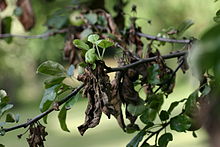Destructive disease caused by the bacterium Erwinia amylovora that occurs in plants in the pome family; symptoms include a blackening of shoots. as though burned
This article includes a list of references, but its sources remain unclear because it has insufficient inline citations. (April 2009) (Learn how and when to remove this template message) |
| Erwinia amylovora | |
|---|---|

| |
| Scientific classification | |
| Domain: | |
| Kingdom: | |
| Phylum: | |
| Class: | |
| Order: | |
| Family: | |
| Genus: | |
| Species: | E. amylovora
|
| Binomial name | |
| Erwinia amylovora (Burrill 1882) Winslow et al. 1920
Type strain = NCPPB 683 | |
Fire blight, also written fireblight, is a contagious disease affecting apples, pears, and some other members of the family Rosaceae. It is a serious concern to apple and pear producers. Under optimal conditions, it can destroy an entire orchard in a single growing season.
The causal pathogen is Erwinia amylovora, a Gram-negative bacterium in the family Enterobacteriaceae. Pears are the most susceptible, but apples, loquat, crabapples, quinces, hawthorn, cotoneaster, Pyracantha, raspberry and some other rosaceous plants are also vulnerable. The disease is believed to be indigenous to North America, from where it spread to most of the rest of the world.
Fire blight is not believed to be present in Australia though it might possibly exist there. It has been a major reason for a long-standing embargo on the importation of New Zealand apples to Australia. Japan was likewise believed to be without the disease, but it was discovered in pears grown in northern Japan. Japanese authorities are, however, still denying its existence, and the Japanese scientist who discovered it is believed to have committed suicide after his name was leaked to affected farmers. In Europe it is listed as a quarantine disease, and has been spreading along Hawthorn (Crataegus) hedges planted alongside railways, motorways and main roads.
